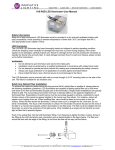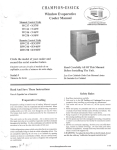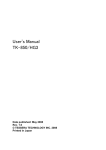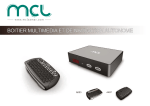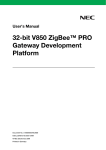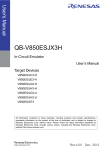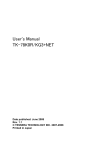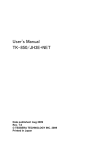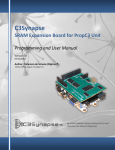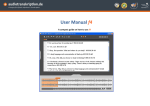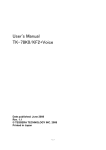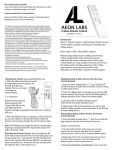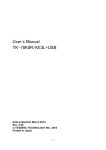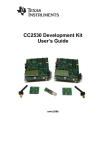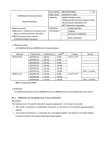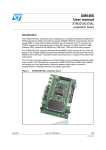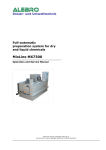Download User`s Manual TK-850/JH3U-SP
Transcript
User’s Manual TK-850/JH3U-SP Date published: November 2008 Rev. 1.0 © TESSERA TECHNOLOGY INC. 2008 Printed in Japan TK-850/JH3U-SP User’s Manual Windows and Windows XP are registered trademarks or trademarks of Microsoft Corporation in the United States and/or other countries. ・The information is subject to change without notice. ・No part of this document may be copied or reproduced in any form or by any means without prior written consent of TESSERA TECHNOLOGY INC.. TESSERA TECHNOLOGY INC. assumes no responsibility for any errors that may appear in this document. ・TESSERA TECHNOLOGY INC. does not assume any liability for infringement of patents, copyrights or other intellectual property rights of third parties by or arising from the use of TESSERA TECHNOLOGY INC. products listed in this document or any other liability arising from the use of such products. No license, express, implied or otherwise, is granted under any patents, copyrights or other intellectual property rights of TESSERA TECHNOLOGY INC. or others. ・Descriptions of circuits, software and other related information in this document are provided for illustrative purposes in semiconductor product operation and application examples. The incorporation of these circuits, software and information in the design of a customer's equipment shall be done under the full responsibility of the customer. TESSERA TECHNOLOGY INC. assumes no responsibility for any losses incurred by customers or third parties arising from the use of these circuits, software and information. CAUTION ・Do not give any physical damage to this equipment such as dropping ・Do not superimpose voltage to this equipment. ・Do not use this equipment with the temperature below 0℃ or over 40℃. ・Make sure the USB cables are properly connected. ・Do not bend or stretch the USB cables. ・Keep this equipment away from water. ・Take extra care to electric shock. ・This equipment should be handled like a CMOS semiconductor device. The user must take all precautions to avoid build-up of static electricity while working with this equipment. ・All test and measurement tool including the workbench must be grounded. ・The user/operator must be grounded using the wrist strap. ・The connectors and/or device pins should not be touched with bare hands. -2- TK-850/JH3U-SP User’s Manual Contents CHAPTER 1 PREPARATION.....................................................................................................................................................8 1.1 Development Tools / Software..............................................................................................................................9 1.2 Installation of Development Tools ..................................................................................................................... 10 1.2.1 Installation Package .................................................................................................................................. 10 1.2.2 Installation of Development Tools....................................................................................................... 10 1.3 Sample Programs...................................................................................................................................................... 15 1.3.1 Preparation of Sample Programs......................................................................................................... 15 1.3.2 Overview of Sample Programs ............................................................................................................. 18 1.4 Installation of USB Driver ..................................................................................................................................... 19 1.4.1 Installation on Windows XP.................................................................................................................... 20 1.4.2 Installation on Windows 2000 ................................................................................................................ 23 1.4.3 Completion of USB Driver Installation............................................................................................... 26 CHAPTER 2 EXPERIENCES................................................................................................................................................... 27 2.1 Start PM+ .................................................................................................................................................................... 29 2.2 What is PM+................................................................................................................................................................ 30 2.3 Load Workspace (project) ..................................................................................................................................... 32 2.4 Set Options................................................................................................................................................................. 34 2.4.1 "Extend" Tab............................................................................................................................................... 34 2.4.2 “Preprocessor” Tab ................................................................................................................................. 35 2.5 Create Load Module Files ..................................................................................................................................... 36 2.6 Check Debugger Settings...................................................................................................................................... 38 2.7 Check Board Settings............................................................................................................................................. 40 2.8 Start Debugger (ID850QB).................................................................................................................................... 41 2.9 Run Programs............................................................................................................................................................. 44 2.10 Stop Programs ........................................................................................................................................................ 47 2.11 Close Debugger (ID850QB) ................................................................................................................................ 48 2.12 Quit PM+.................................................................................................................................................................... 49 CHAPTER 3 HARDWARE SPECIFICATIONS .................................................................................................................. 50 3.1 Connecter Layout..................................................................................................................................................... 51 3.2 Function Layout ........................................................................................................................................................ 52 3.3 Hardware Functions................................................................................................................................................. 53 3.3.1 SW1.................................................................................................................................................................. 53 3.3.2 SW2 (RESET SW)....................................................................................................................................... 54 3.3.3 SW3 (INTP12) .............................................................................................................................................. 54 3.3.4 SW4 (INTP13) .............................................................................................................................................. 54 3.3.5 LED1................................................................................................................................................................ 55 3.3.6 LED2 (POWER) ........................................................................................................................................... 55 3.3.7 U20 (for no LCD version) ....................................................................................................................... 55 3.3.8 JP1 .................................................................................................................................................................. 56 -3- TK-850/JH3U-SP User’s Manual 3.3.9 JP2 .................................................................................................................................................................. 56 3.3.10 CN1 ............................................................................................................................................................... 56 3.3.11 CN2 ............................................................................................................................................................... 56 3.3.12 CN4 ............................................................................................................................................................... 56 3.3.13 CN7 ............................................................................................................................................................... 56 3.3.14 CN8 ............................................................................................................................................................... 57 3.3.15 CN9 ............................................................................................................................................................... 57 3.3.16 J1................................................................................................................................................................... 57 3.3.17 NWIRE1 Connector ................................................................................................................................. 57 3.3.18 USB1 Connecter...................................................................................................................................... 57 3.3.19 USB2 Connecter...................................................................................................................................... 57 3.3.20 USB3 Connecter...................................................................................................................................... 57 3.3.21 DSUB1 Connecter................................................................................................................................... 58 3.3.22 U24 (IrDA Infrared communication module).................................................................................. 58 3.3.23 VR1................................................................................................................................................................ 58 3.4 solder-short pad label............................................................................................................................................. 59 3.5 Explanation of unit ................................................................................................................................................... 60 3.5.1 USB function ............................................................................................................................................... 60 3.5.2 USB Host ...................................................................................................................................................... 61 3.5.3 IrDA infrared communication................................................................................................................. 62 3.5.4 Ethernet......................................................................................................................................................... 63 3.5.5 Touch panel LCD (LCD version only) ................................................................................................ 64 3.5.6 SRAM.............................................................................................................................................................. 65 3.5.7 External bus interface.............................................................................................................................. 66 1.1. External bus I/F devices ...................................................................................................................................... 66 1.2. Address mapping...................................................................................................................................................... 66 1.3. External memory address area........................................................................................................................... 66 3.5.8 External connecter.................................................................................................................................... 67 3.5.9 Audio input.................................................................................................................................................... 69 3.5.10 Audio output.............................................................................................................................................. 70 3.5.11 RS-232C ..................................................................................................................................................... 71 CHAPTER 4 TROUBLESHOOTING..................................................................................................................................... 72 4.1 If you cannot find USB driver when you connect PC to the kit............................................................ 72 4.2 Error when you start the debugger ................................................................................................................... 72 4.2.1 "Can not communicate with Emulator..." (F0100 or A0109) .................................................... 72 4.2.2 "Incorrect ID Code." (Ff603) ................................................................................................................ 73 4.3 Monitor memory cannot be accessed. (F0c72) ............................................................................................ 73 CHAPTER 5 OTHER INFORMATION.................................................................................................................................. 74 5.1 Create a new workspace ....................................................................................................................................... 75 5.2 Register additional source file ............................................................................................................................. 83 5.3 Debugger tips ............................................................................................................................................................. 85 -4- TK-850/JH3U-SP User’s Manual 5.3.1 Change display of buttons...................................................................................................................... 85 5.3.2 Display source list and function list ................................................................................................... 85 5.3.3 Set/delete breakpoints............................................................................................................................ 86 5.3.4 Display global variables............................................................................................................................ 87 5.3.5 Display local variables.............................................................................................................................. 88 5.3.6 Display memory and SFR contents .................................................................................................... 88 5.4 WriteEZ1....................................................................................................................................................................... 89 5.5 Circuit diagram........................................................................................................................................................... 94 -5- TK-850/JH3U-SP User’s Manual Introduction TK-850/JH3U-SP is the evaluation kit for development using "V850ES/JH3-U", NEC Electronics 32bit all flash microcontroller. The user only needs to install the development tools and USB driver, and connect the host machine with the target board to start the code development, build, monitoring the output, and debugging code. (This demonstration kit uses the on-chip debug feature from the microcontroller itself, without emulator connection) Configuration for Debugging -6- TK-850/JH3U-SP User’s Manual Overview This manual consists of the following contents. Read chapter 1 and 2 first for installing the development tools and using the sample programs. Read chapter 3-5 for customizing the sample programs and the hardware. Chapter 1: Chapter 2: Chapter 3: Chapter 4: Chapter 5: Preparations Install the development tools Experiences Experience the basic operations of integrated development environment (PM+) and integrated debugger (ID850QB) with using sample programs. Hardware Specifications Explain the hardware of TK-850/JH3U-SP Troubleshooting Describe how to solve troubles you may face, such as errors when starting the integrated debugger (ID850QB) Other Information Introduce other information, such as how to create a new workspace (project) on integrated development environment (PM+), how to register additional source file, and some useful tips of the integrated debugger. The circuit diagrams of demonstration kit are included in this chapter. Reader This manual is intended for development engineers who wish to become familiar with the development tools for the V850. It is assumed that the readers have been familiar with basics of microcontrollers, C and Assembler languages, and the WindowsTM operating system. Purpose This manual is intended to give users an understanding of the features, hardware configurations, development tools for the V850. -7- TK-850/JH3U-SP User’s Manual CHAPTER 1 Preparation This - chapter describes following topics: Overview and installation of development tools Installation of development tools Overview and preparation of sample programs Users can experience the development flow such as coding, build, debugging, and test, by using the development tools bundled with TK-850/JH3U-SP. -8- TK-850/JH3U-SP User’s Manual 1.1 Development Tools / Software ● Device file DF703771 V1.00 A device file contains device specific information. So, users need a device file to use the development tools. ● Integrated Development Environment (IDE) PM+ V6.31 The IDE works on Windows operation system. Users can develop a system efficiently by using the editor with idea processor function, compiler, and debugger. ● C Compiler CA850 W3.20 (code size limited version) C compiler for the V850 microcontrollers. The object code size is limited to 128 Kbyte. This compiles C code for V850 and ANSI-C code program into assembler code. This produces object code and linker. ● V850 Integrated Debugger ID850QB V3.50 This is the tool for debugging the object program generated by C compiler and assembler. The debugger enables to do C source level debugging. With the debugger, you can debug the code easily and efficiently by refering and changing variables, using step-in debuging function, and so on. ● Built-in Flash Memory Writing Program WriteEZ1 This is the Windows software to write programs on built-in flash memory. By connecting TK-850/JH3U-SP and PC with bundled USB cable, you can write/delete programs on the built-in flash memory. ● Sample program The explanation uses Mass storage class (MSC) sample program in user's manual. -9- TK-850/JH3U-SP User’s Manual 1.2 Installation of Development Tools 1.2.1 Installation Package The attached CD-ROM includes the development tools and documentations. Users can use the installer to install those development tools and documentations. 1.2.2 Installation of Development Tools ① Please insert the CD-ROM in the drive. The installer will show up automatically. If it does not start automatically, please initiate it by double clicking the SETUP.EXE. <1> Readme First The contents of the CD-ROM, and some notes are available. Please read it at first. <2> Install… Click “Install” to start installation of development tools. For details, please refer to the next section. - 10 - TK-850/JH3U-SP User’s Manual <3> Documents Manuals of development tools and the evaluation kit are available in PDF files. When this button is clicked, the WWW browser will start. Adobe® Acrobat® Reader is available in the CD-ROM. <4> Sample Program Click this button to start the WWW browser for the sample program and the tutorial. <5> Link to NEC Electronics Microcontrollers Click this button to start the WWW browser display the link to the NEC Electronics Microcontroller web site (http://www.necel.com/micro/index_e.html) The NEC Electronics Microcontroller web page provides with the latest product/tool information and FAQs. <6> Exit Terminate the setup. ② Click the "Install" - 11 - TK-850/JH3U-SP User’s Manual ③ "Tool Installer" dialog box is opened. Select products that you need to install. (as default, all the products that you need to use the TK-850/JH3U-SP are selected.) "Explain" area displays an explanation of the selected product. To change the installation destination, click Browse… . When all the settings are completed, click Install… . * In this document, it is assumed that users install the programs under "NEC Electronics Tools" directory (default installation directory). Users can find the tools by selecting “Start Menu” -> "Programs" -> "NEC Electronics Tools". ④ Click OK when "Install" comfirmation dialog box is opened. - 12 - TK-850/JH3U-SP User’s Manual ⑤ Read "software license agreement" and click To stop the installation, click No . Yes ⑥ Enter the product ID, and click Next . * The product ID is available on the other sheet. ⑦ It starts copying the files. - 13 - for continuing the installation. TK-850/JH3U-SP User’s Manual ⑧ If the “install Wizard :Kind of File” dialog displayed, Select ”Device File For V850ES/JH3-U”. Click OK . ⑨ When the installation is completed, the following dialog opens. Click OK . Notes on the installation authority To install this tool in Windows 2000 or XP, the authority of an administrator is necessary. Therefore, please login as an administrator. Notes on the install-directory Please do not use 2-byte characters, such as umlaut in the directory name, where the product is to be installed. Note on the version of Windows If the language of the Windows is not English, a file transfer error during installation might be observed. In this case, please abort the installation in the language, and re-install it in an English version of Windows. The identical problem may be observed, if a language other than English is specified as the system language in the “Regional Settings Properties” tab. Limitation Assembler RA850 and C compiler CA850 limit the object size to 128Kbyte. - 14 - TK-850/JH3U-SP User’s Manual 1.3 Sample Programs This section explains the overview and preparation of sample programs. 1.3.1 Preparation of Sample Programs ① Insert the CD-ROM disk in the CD-ROM drive of your PC. The [NEC Electronics Microprocessor Development Tools Setup] screen automatically appears.(if this screen does not appear automatically, start setup.exe from Explorer. etc.) ② Press the Sample Program button to start the WWW browser. - 15 - TK-850/JH3U-SP User’s Manual ③ Click the “Mass Storage Class Sample Program MSC Sample Driver ” link , the following download confimation window appears. ④ Click the Save butten. - 16 - TK-850/JH3U-SP User’s Manual ⑤ After specifying the download destination folder,click the Save button. ⑥ The self-extraction sample program (JH3U_STORAGE.EXE) is copied to the specified folder. The folder that the “TK850” folder is made when this file is executed, and the sample program is stored under the”TK850” folder. - 17 - TK-850/JH3U-SP User’s Manual 1.3.2 Overview of Sample Programs The “Mass Storage Class Sample Program MSC Sample Driver” consist of following folders. TK850 JH3U_STORAGE include NEC_Project src Include files Project files for NEC compiler Source files - 18 - TK-850/JH3U-SP User’s Manual 1.4 Installation of USB Driver "NEC Electronics Starter Kit Virtual UART" USB driver must be installed on PC before you start using the TK-850/JH3U-SP. Please, follow the instruction below to install the driver. "Starter Kit USB Driver" must be installed on the PC. If not, please refer to "1.2 Installation of Development Tools" to install the driver first. CAUTION: Do not use a USB hub for connecting TK-850 First, connect the TK-850 to PC with USB. USB cable Depending on the version of Windows OS, the installation will be differed. Please check your Windows version, and follow the instructions - Windows XP -> "1.4.1 Installation on Windows XP" - Windows 2000 -> "1.4.2 Installation on Windows 2000" After the installation, go to "1.4.3 Completion of USB Driver Installation" 8 - 19 - TK-850/JH3U-SP User’s Manual 1.4.1 Installation on Windows XP 1. Once the TK-850/JH3U-SP is connected with USB, the "Found New Hardware Wizard" will be started. Select "No, not this time" and click Next > . Select "No, not this time" Click "Next" 2. Select "Install from a list or specific location" and click Next > . Select "Install from a list or specific location" Click "Next" - 20 - TK-850/JH3U-SP User’s Manual 3. Select "Search for the best driver in these locations.", check "Include this location in the search:", and then click "Browse..." to select the driver directory path. The path should be "C:\Program Files\NEC Electronics Tools\TK-driver" as default installation. If the installation directory is not default, then select "TK-driver" under the installation directory. Click Next > . Select the driver directory Click "Next" 4. If the following dialog is opened, click Continue Anyway . Click "Continue Anyway" - 21 - TK-850/JH3U-SP User’s Manual 5. The installation of "NEC Electronics Starter Kit Virtual UART" driver is completed. Click Finish . Click "Finish" 6. Go to "1.4.3 Completion of USB Driver Installation". - 22 - TK-850/JH3U-SP User’s Manual 1.4.2 Installation on Windows 2000 1. Once the TK-850/JH3U-SP is connected with USB, the "Found New Hardware Wizard" will be started. Select "No, not this time" and click Next > . Click "Next" 2. Select "Search for a suitable driver for my device". Click Next > . Select "Search for a suitable driver for my device" Click "Next" - 23 - TK-850/JH3U-SP User’s Manual 3. Select "Specify a location". Click Next > . Select "Specify a location" Click "Next" 4. Select the driver directory path. The path should be "C:\Program Files\NEC Electronics Tools\TK-driver" as default installation. If the installation directory is not default, then select "TK-driver" under the installation directory. Click OK . Click "OK" Select the driver directory - 24 - TK-850/JH3U-SP User’s Manual 5. Click Next > . Click "Next" 6. The installation of "NEC Electronics Starter Kit Virtual UART" driver is completed. Click Finish . Click "Finish" 7. Go to "1.4.3 Completion of USB Driver Installation". - 25 - TK-850/JH3U-SP User’s Manual 1.4.3 Completion of USB Driver Installation Confirm the USB driver is installed on PC. Start "Device Manager", and find "NEC Electronics Starter Kit Virtual UART" (without "?" mark) under the "Ports (COM & LPT)". Device Manager Find "NEC Electronics Starter Kit Virtual UART (COMx)" The screen above shows that the COM port number is "COM8". If ID850QB is not in use, you can use this port number for connecting TK-850/JH3U-SP. When you change the USB port connection, the COM port number will be changed as well. CAUTION ・Do not do “Hardware Modification Scan” when you communicate with the target device. - 26 - TK-850/JH3U-SP User’s Manual CHAPTER 2 Experiences In this chapter, you will experience how to use the development tools with using the sample programs. The development tools are : - Integrated Development Environment (IDE), PM+ - Integrated Debugger, ID850QB You will use the programs that you prepared in "1.3 Sample Programs", as the sample programs for TK-850/JH3U-SP You will be able to understand how to use the development tools and the concept of project files which you need for producing application programs. - 27 - TK-850/JH3U-SP User’s Manual The overall steps are as follows: 2.1 Start PM+ 2.3 Load Workspace 2.4 Set Linker Options 2.5 Set Compiler Options 2.6 Create Load Module Files 2.7 Check Debugger Settings 2.8 Check Board Settings Run Programs 2.9 Start Debugger 2.10 Run Programs 2.11 Stop Programs 2.12 Close Debugger 2.13 Quit PM+ - 28 - TK-850/JH3U-SP User’s Manual 2.1 Start PM+ Let's start using the development tools. First, start the PM+ Select "Windows Start Menu" -> "Program" -> "NEC Electronics Tools" -> "PM+ V6.31". PM+ starts up - 29 - TK-850/JH3U-SP User’s Manual 2.2 What is PM+ In PM+, application programs and environment setting are handled as a single project, and series of actions such as program creation using the editor, source management, build, and debugging are managed. Also, one of more project files is managed together as a workspace. Menu bar Project Window Project window Tool bar Output Window A window in which project names, source files, and include file are displayed using a tree structure. Output window A window in which the build execution status is displayed. For details regarding menu bars and tool bars, refer to "Help" menu in PM+. "Help" on menu bar , then "PM+ Help" - 30 - TK-850/JH3U-SP User’s Manual What is a project? A project is the unit that is managed by PM+. A project refers to an application system and environment development based on PM+. PM+ saves project information in a "project file". What is a project file? A project file contains project information that includes the source files, device name, tool options for compiling, editor, and debugger information. The file name format is "xxxxx.prj". Project files are created in the directory you specifies when you create a new workspace. What is a project group? A project group is a group comprised of a number of projects in an application system. The target device of each project must be the same within a project group. What is a workspace? A workspace is the unit used to manage all the projects and project group required for one application system. A workspace file contains one or more project files. The file name format is "xxxxx.prw". - 31 - TK-850/JH3U-SP User’s Manual 2.3 Load Workspace (project) In this section, you will use the workspace that you created in "1.3 Sample Programs" For creating a new workspace, refer to "Chapter 5 Other Information". The workspace has information about the build environment for the sample programs. Select "File" on menu bar and "Open Workspace…". Then, select "V850JH3U_Fnc_MSC.prw " under the directory ”C:\TK850\JH3U_STORAGE\NEC_project". Select the directory that contains the sample programs. Select "V850JH3U_Fnc_MSC.prw", then click - 32 - Open . TK-850/JH3U-SP User’s Manual Workspace name: "V850JH3U_Fnc_MSC.prw Load the workspace file "V850JH3U_Fnc_MSC.prw" Project group Project The workspace file "V850JH3U_Fnc_MSC.prw" contains one project called "V850JH3U_Fnc_MSC". You will use this project "V850JH3U_Fnc_MSC". CAUTION: Please ignore when you get a prompt saying "files could not be found". This may occurred when the installation directory is not a default. - 33 - TK-850/JH3U-SP User’s Manual 2.4 Set Options The compiler options have been set by project file. However, because some compiler options are useful, following two settings are covered specifically in this section. - Enable C++ comments - On-chip debug (Disable/Enable, security ID) Select "Tools" on menu bar, then "Compiler Common options". 2.4.1 "Extend" Tab Select "Device" tab on "Compiler Common Options" window, and check following settings. Set the security ID. The security ID is a specific ID code (10 bytes) used for the authentication when the debugger is starting. The security ID is stored at the address 70H-79H in the microcontroller built-in flash memory. The security ID in the flash memory and the ID entered in the configuration dialog are compared when the debugger is starting. When the ID does not match, the debugger cannot be started. Therefore, it is useful to protect the program data in the memory from others. If you do not need to care about the security, it is recommended to enter "FFFFFFFFFFFFFFFFFFFF". (When you erase the data in the flash memory, the ID is set to this value.) - 34 - TK-850/JH3U-SP User’s Manual If you forgot the security ID code stored in the address 70H-79H, the debugger (ID850QB) will not be able to start. In this case, you need to use "WriteEZ1" to erase the built-in flash memory. By erasing the flash memory, the security ID is set to "FFFFFFFFFFFFFFFFFFFF". For details, refer to "5.4 WriteEZ1". 2.4.2 “Preprocessor” Tab Select "Tool" on menu bar in PM+, then "Compiler Options...". Select "Preprocessor" tab, and check "Use C++ Style Comment". This setting allow you to use the C++ comment using "//". It is useful feature when editing programs. - 35 - TK-850/JH3U-SP User’s Manual 2.5 Create Load Module Files After developing the source code, you have to create load module files by compiling, assembling, and linking. This process is called build. Click the build button , or select "Build" on menu bar, then "Build". Build has been completed successfully. - 36 - TK-850/JH3U-SP User’s Manual What is build? Build is a function that creates an executable file from source files in a project. PM+ automatically performs compiling, assembling, linking, and other processing actions. To reduce the time for the build, PM+ detects and compiles/assembles only the files that have been updated from the previous build process. What is rebuild? Build compiles and assembles only the source files that have been updated from the previous time, whereas rebuild compiles and assembles all the source files. When setting, such as compiler options, have been changed, you must rebuild instead of build. - 37 - TK-850/JH3U-SP User’s Manual 2.6 Check Debugger Settings After the build, you should configure the debugger settings. The debugger settings have been set by the project file as well. However, because those settings are important for debugging, some settings are covered in this section. Select "Tools" on menu bar, then "Debugger Setting...". - 38 - TK-850/JH3U-SP User’s Manual Check if "ID850QB V3.50 V850 Integrated Debugger" is selected on "Debugger". If you cannot select "ID850QB V3.50 V850 Integrated Debugger", select "Project" on menu bar, "Project settings" -> "Tool version settings" -> "Detailsetting" -> then select "ID850QB V3.50". - 39 - TK-850/JH3U-SP User’s Manual 2.7 Check Board Settings Before connecting the PC and the TK-850/JH3U-SP with USB, you should check the setting of SW1 on the board. ① Set JP2 and SW1 as shown below. JP1 :1-2 short SW1 Bit1 Bit2 Bit3 Bit4 ② OFF ON ON ON Connect USB1 connecter on TK-850/JH3U-SP and PC with USB cable. USB cable - 40 - TK-850/JH3U-SP User’s Manual 2.8 Start Debugger (ID850QB) Click the debug button , or select "Build" on menu bar, then "Debug". If you do not see the debug button, go to "2.7 Check Debugger Settings" for changing the settings. The steps to start the debugger will be explained below. ID850QB is launched - 41 - TK-850/JH3U-SP User’s Manual "Configuration" dialog is opened. Follow the settings below and click "OK". ・Enter "6" in "Main OSC" ・Enter “8” in "Multiply rate" ・Enter "FFFFFFFFFFFFFFFFFFFF" (F x 20) in "ID Code". ・Select "UARTD0" in "Port" at "Target Device Connection" area then click Click OK . Yes when the confirmation dialog for downloading load module file is opened. - 42 - TK-850/JH3U-SP User’s Manual ID850QB starts and downloading the program to flash memory. When the download is completed, the source code will be displayed NOTE: Completion of the download does not mean running the programs. Therefore, even though you press switch on the board, it does not make anything happened. To run the sample program demonstration, see "2.9 Run Programs". - 43 - TK-850/JH3U-SP User’s Manual 2.9 Run Programs Now, you are ready to run the program. Click the restart button , or select "Run" on menu bar, then "Restart". The sample program runs. Run the sample program When programs are running, the status bar will be red. - 44 - TK-850/JH3U-SP User’s Manual Connect USB3 and PC with another USB cable while USB1 is still connected. USB cable When it is connected to PC, the driver is automatically installed. It is detected as "NEC corp TK-850JG3-H/JH3- USB Device" under disk drive. - 45 - TK-850/JH3U-SP User’s Manual Also, the removable disk is added as a disk drive. This drive is not formatted. You can use this as 24KB removable disk when you format it. Now you could check the mass storage class (MSC) sample program is functioning. ● The program downloaded with ID850QB cannot be executed without ID850QB connection. If you need to execute it with stand-alone, use WriteEZ1 to write HEX file. For more information, refer to "5.4 WriteEZ1". - 46 - TK-850/JH3U-SP User’s Manual 2.10 Stop Programs Now, you are going to stop the program. Click the stop button , or select "Run" on menu bar, then "Stop". Stop the program When the program stops, the status bar changes back to the original color. - 47 - TK-850/JH3U-SP User’s Manual 2.11 Close Debugger (ID850QB) Select "File" on menu bar, then "Exit". The exit confirmation dialog is displayed. If you click Yes , it saves the settings in the project file, and then closes the ID850QB. It is recommended to save the settings as it saves the window you used, window size, layout, etc. If you click No , it does not save the settings and closes the ID850QB. - 48 - TK-850/JH3U-SP User’s Manual 2.12 Quit PM+ Select "File" on menu bar, then "Exit PM+". PM+ is closed. The experiences section ends now. You can find more information how to use the development tool and information about other useful features in "Chapter 5 Other Information". - 49 - TK-850/JH3U-SP User’s Manual CHAPTER 3 Hardware Specifications In this chapter, the hardware of TK-850/JH3U-SP will be explained. Microcontroller Clock Interface Other unit Dimension Power supply voltage μPD70F3769 ※V850ES/JH3-U External main system clock: 48MHz (6MHz x8) Sub-clock: 32.768KHz USB (A receptacle) x1 USB (MINI B connecter) x2 Connecter for N-Wire (For KEL connecter) Connecter for MINICUBE2 (For SICA connecter only pad) Dsub-9Pin x1 Expansion connector (50Pin) RJ-45 connecter IrDA communication interface Audio input (φ3.5mm monaural jack) Audio output (φ3.5mm monaural jack) AC adopter jack (5V) Touch panel LCD (for LCD version) 7Seg-LED (for no LCD version) 100mm x 136mm 5V - 50 - TK-850/JH3U-SP User’s Manual 3.1 Connecter Layout USB2 DSUB1 USB3 USB1 NWIRE1 CN1 CN2 CN9 - 51 - CN7 CN4 CN8 TK-850/JH3U-SP User’s Manual 3.2 Function Layout LED1 SW2 U24 JP2 SW1 LED2 U20 - 52 - SW3 SW4 VR1 JP1 TK-850/JH3U-SP User’s Manual 3.3 Hardware Functions 3.3.1 SW1 The bit 1-4 on SW1 are for mode settings, Bit5-8 of SW1 are connected to ”P78/ANI8”~” P711/ANI11” for general-purpose input port. ● For the use of ID850QB, use following settings. SW1 Bit1 Bit2 Bit3 Bit4 * OFF ON ON ON When ID850QB is used, these terminals cannot be used because it communicates with the host machine by using and the terminal P30 and P31. ● Please change to the following settings when writing it in the flash memory with built-in CPU by using WriteEZ1. (The hardware of WriteEZ1 is built into TK-850/JH3U-SP.) SW1 Bit1 Bit2 Bit3 Bit4 OFF ON ON ON ● To run the programs stored in built-in flash memory by WriteEZ1, use following settings and re-supply power. SW1 Bit1 Bit2 Bit3 Bit4 OFF OFF OFF OFF ※ ※If you need to use USB1 as virtual serial port, set Bit4 to ON. - 53 - TK-850/JH3U-SP User’s Manual ● Please change to the following settings when you connect N-Wire emulator. SW1 Bit1 Bit2 Bit3 Bit4 OFF OFF OFF OFF ● Please change to the following settings when you use virtual serial COM port. SW1 Bit1 Bit2 Bit3 Bit4 OFF OFF OFF ON ※ ※If you need to use USB1 as virtual serial port, set Bit4 to ON. ● Bit5-8 are connected to following CPU pins. As they are connected to pull-up resister, "ON" means "Low" and "OFF" means "High". SW1 Bit5 Bit6 Bit7 Bit8 P78 P79 P710 P711 3.3.2 SW2 (RESET SW) This is the reset switch. You can reset the microcontroller by pressing this switch. 3.3.3 SW3 (INTP12) SW3 is the push switch connected to ”P98/SOF1/INTP12/A8” pin in CPU. There are connecting to pull-up resister. When the switch is pushed down, it sends the signal of "Low". 3.3.4 SW4 (INTP13) SW4 is the push switch connected to ”P99/SCKF1/INTP13/A9” pin in CPU. There are connecting to pull-up resister. When the switch is pushed down, it sends the signal of "Low". - 54 - TK-850/JH3U-SP User’s Manual 3.3.5 LED1 This is the Bus Power LED for USB2 connecter. It is lighted when USB2 connecter gets power supply. 3.3.6 LED2 (POWER) This is the POWER LED. It is lighted when it gets power supply. 3.3.7 U20 (for no LCD version) This is the 7Seg-LED. 7Seg-LED display can be changed by accessing the address between 600000h and 6FFFFFh. U20 Bit0 Bit5 Bit1 Bit6 Bit4 Bit2 Bit3 0 1 2 3 4 Bit7 Example of displayed figure and set data. 0xC0 5 0x92 0xF9 0xA4 0xB0 0x99 6 7 8 9 - 55 - 0x83 0xf8 0x80 0x98 TK-850/JH3U-SP User’s Manual 3.3.8 JP1 JP1 is a jumper short pin to select power supply for CN8 MIC INPUT. Set the jumper to short when you connect electret condenser microphone. 3.3.9 JP2 JP2 is a jumper short pin to select power supply. 1-2 short 3-4 short 5-6 short Use power supply from USB1 connecter. Use power supply from USB3 connecter. Use power supply from AC adapter connected to CN9. Caution When you use USB host connection with USB2 or use LCD display, you must use power supply from AC adapter. 3.3.10 CN1 CN1 is an extended connecter. FX8C-100P-SV6 connecter by Hirose Electric Co., LTD. is mounted. 3.3.11 CN2 CN2 is a connecter pad for MINICUBE2 connection (connecter is not mounted). 3.3.12 CN4 CN4 is RJ-45 connecter socket for Ethernet connection. 3.3.13 CN7 CN7 is an audio output connecter. P10/ANO0 signal output is output through low-pass filter. Connect φ3.5mm mini plug. - 56 - TK-850/JH3U-SP User’s Manual 3.3.14 CN8 CN8 is an audio input connecter. P72/ANI2 inputs signal through low-pass filter. Connect φ3.5mm mini plug. 3.3.15 CN9 CN4 is the power supply connecter of the AC adaptor. You can supply the power by setting the JP2 to 5-6 short and connect AC adapter. 3.3.16 J1 This is the connector for external power supply. (DC5V) 3.3.17 NWIRE1 Connector These are connector for N-Wire emulator. It can connect N-Wire emulator of IE-V850E1-CD-NW etc. 8831E-026-170L-F connecter by KEL Corp. is mounted. 3.3.18 USB1 Connecter This is a connecter for on-chip debug and flash memory writing. This can be used as a virtual serial COM port by setting SW1. 3.3.19 USB2 Connecter This is a connecter for USB host connection. Caution When you use USB host connection with USB2 or use LCD display, you must use power supply from AC adapter. 3.3.20 USB3 Connecter This is a connecter for USB function connection. - 57 - TK-850/JH3U-SP User’s Manual 3.3.21 DSUB1 Connecter This is a Dsub-9Pin connecter for RS-232C communication. RS-232C communication can be made with using P90/TXDC1 and P91/RXDC1. 3.3.22 U24 (IrDA Infrared communication module) This is an IrDA infrared communication module. 3.3.23 VR1 This is an initial level volume control for the audio input (CN8) signal. - 58 - TK-850/JH3U-SP User’s Manual 3.4 solder-short pad label When using an external connector without using a circuit on board, in order to separate a circuit on board, the terminal of CPU can be customized by making the pad for solder short opening. Pad for solder-short has shape like the figure below. When you make an open circuit, cut the narrow part of the Pad with a knife. To make short circuit, join the separated Pad with a soldering iron etc. Solder-short pad (opened shape) Solder-short pad name Solder-short pad Shorted shape State when shipping it T_RESET Short FLMD0 Short USB_P1 Open TXDC1 Short RXDC1 Short P1 Short Connection Connect reset IC to T_RESET signal Open when reset IC is not in use. FLMD0 to P37 on CPU Short when built-in flash memory is rewritten by self USB Host bus power switch output Short when you set maximum bus power output current to 1A. Connect P90/TXDC1 and RS-232C driver. Open when you use it not for RS-232C. Connect P91/RXDC1 and RS-232C driver. Open when you use it not for RS-232C. Connect RTC and CTS of RS-232C. Open when RTC and CTS should be disconnected. P2 Short VOLUME1 Short Connect DSR and DTR of RS-232C. Open when DSR and DTR should be disconnected. Audio output volume signal and P11/ANO1 Open when P11/ANO1 should be disconnected. - 59 - TK-850/JH3U-SP User’s Manual 3.5 Explanation of unit 3.5.1 USB function zUSB connecter Mini B receptacle USB Function block diagram 3.3V Power supply V850ES/JH3-U Power supply Pull-Up signal Pull-Up control USB signal Pull-up Circuit Vbus USB Conncter Pull-up USB data V850ES/JH3-U pin Connecter UDPF UDMF P41/SOF0/RXDC4/SCL01 P42/_SCKF0/INTP10 D+ D- V850ES/JH3-U Signal direction I/O I/O Out In - 60 - Note 3.3V 1.5kΩPull-up D+ Pull-up control D+ Pull-up signal USB TK-850/JH3U-SP User’s Manual 3.5.2 USB Host zUSB connecter A receptacle zWhen you use USB host connection with USB2, you must use power supply from AC adapter for supplying USB bus power. USB Host block diagram 5.0V power supply V850ES/JH3-U Vbus Power ON signal Power supply Controller Vbus power supply USB connecter Vbus Current fault signal USB data V850ES/JH3-U pin Connecter D+ D- V850ES/JH3-U Signal direction I/O I/O Out UDPH UDMH P34/TIAA10/TOAA10/TO AA1OFF/INTP09/PPON P35/TIAA11/TOAA11/RT C1HZ/OCI Vbus Power ON - In Vbus Current fault signal - 61 - Note USB TK-850/JH3U-SP User’s Manual 3.5.3 IrDA infrared communication zIrDA controller ITX E-Globaledge LC16MI-0110A zIrDA module ROHM RPM971-H14 zIrDA controller register base address 0x400000 IrDA block diagram 3.3V power supply 1.8V power supply V850ES/JH3-U EXT bus IrDA Controller IrDA Module Interrupt clock 48MHz Oscillator IrDA controller pin A0~A7 D0~D7 _RD _WE _CS _INTR _RESET XIN/CLK48M V850ES/JH3-U pin A1~A8 AD0~AD7 _RD _WR1 → P05/INTP04 → - V850ES/JH3-U Signal direction Out I/O Out Out Note Connect to address decoder Interrupt to CPU Connect to reset circuit Input from shared USB clock In - - 62 - Ir Communication TK-850/JH3U-SP User’s Manual 3.5.4 Ethernet zLAN controller ASIX AX88796B zRJ45 Jack With Magnetic Module TAIMAG RJLBC-248TA1 zEthernet controller register address 0x500000 Ethernet block diagram 3.3V power supply Ethernet V850ES/JH3-U EXT bus RJ45 Jack with Magnetic Module LAN Controller LINK State LED Speed State LED Interrupt Serial EEPROM (MAC address) Clock 25MHz Oscillator LAN controller pin SA0~SA5 D0~D15 nRD nWE nCS nRESET IRQ V850ES/JH3-U pin A1~A5 AD0~AD15 _RD _WR1 → → P04/INTP03 V850ES/JH3-U Signal direction Out I/O Out Out Note Connect to address decoder Connect to reset circuit Interrupt to CPU In - 63 - TK-850/JH3U-SP User’s Manual 3.5.5 Touch panel LCD (LCD version only) zLCD panel CASIO zLCD controller Epson zLCD controller register base address zLCD controller memory base address COM50T5117GTC (5.0inch QVGA color) S1D13A05F00AB00B 0x600000 0x680000 Caution When you use LCD display, you must use power supply from AC adapter. Touch Panel LCD block diagram 3.3V power supply 2.5V power supply V850ES/JH3-U EXT bus LCD controller Reset circuit CSI2 A/D Port Display data LCD panel Serial communication Touch panel signal 5.0V power supply Port output Back light LED driver Enable signal LCD controller LCD controller pin AB[17:1] DB[15:0] CS# AB0 M/R# CLKI RD/WR# RD# WE0# WE1# WAIT# RESET# V850ES/JH3-U pin A1~A17 AD0~AD15 → → A19 CLKOUT _RD _RD _WR0 _WR1 _WAIT → V850ES/JH3-U Signal direction Out I/O Note Address decode GND Out Out Out Out Out Out In Bus clock Connect to reset circuit - 64 - TK-850/JH3U-SP User’s Manual Touch panel LCD connection LCD panel V850ES/JH3-U pin Note P97/SIF1/TIAA20/TOAA20/A7 V850ES/JH3-U Signal direction OUT YU XR P96/TIAA21/TOAA21/INTP11/A6 OUT Output port YL A/D in OUT A/D in OUT A/D input Output port A/D input Output port CSI CSI Out LCD control LCD control LCD control /RESET P71/ANI1 P95/TIAA30/TOAA30/A5 P70/ANI0 P94/TIAA31/TOAA31/TENC00/EV TT00/A4 P23/_SCKF2/KR5/RTP05 P22/SOF2/KR4/RTP04 P21/SIF2/TIAB00/KR3/TOAB00/R TP03 → BLON → XL SCL SI / CS 3.5.6 SRAM z1Mbyte (8Mbit) SRAM is installed. zSRAM memory base address 0x100000 - 65 - Output port Connect to reset circuit Back light enable output TK-850/JH3U-SP User’s Manual 3.5.7 External bus interface 1.1. External bus I/F devices Device IrDA controller LAN controller LCD controller SRAM Address pin A0-7 SA0-5 M/R, AB1-17 A0-18 Accessing condition 16bit access 16bit access 16bit access 16bit access Note The device is 8bit A1 is 2Byte pin AB1 is 2Byte pin 1MByte 1.2. Address mapping zThe address decoder assigns 4 devices to 010 0000H~01FFFFFH (CS0 area)と 040 0000H~07F FFFFH (CS2 area). Adress Assign 07FFFFF 1MB 0700000 06BFFFF LCD mem 0680000 1MB User area 061FFFF LCD Reg 0600000 1MB 05000FF Ethernet 0500000 1MB 04001FF IrDA 0400000 Address Assign 01FFFFF External 1MB SRAM 0100000 00FFFFF Internal 1MB ROM 0000000 1.3. External memory address area z070 0000H~07F FFFFH (CS2 area) 1MByte size z080 0000H~0FF FFFFH (CS3 area) 8MByte size - 66 - User area TK-850/JH3U-SP User’s Manual 3.5.8 External connecter zYou can connect external bus signals to external devices with external connecter (CN1) (HIROSE FX8C-100P-SV4) External conncter block diagram V850ES/JH3-U EXT bus EXT connecter Ports Power - 67 - TK-850/JH3U-SP User’s Manual External connecter connections No. 1 3 5 7 9 11 13 15 17 19 21 23 25 27 29 31 33 35 37 39 41 43 45 47 49 51 53 55 57 59 61 63 65 67 69 71 73 75 77 79 81 83 85 87 89 91 93 95 97 99 V850ES/JH3-U pin A0 A1 A2 A3 A4 A5 A6 A7 A8 A9 A10 A11 A12 A13 A14 A15 PCM0/WAIT PCM1/CLKOUT CS_USER_n PCS2/CS2 PCS3/CS3 PCT0/WR0 PCT1/WR1 PCT4/RD PCT6/ASTB PDH0/A16 PDH1/A17 PDH2/A18 PDH3/A19 PDH4/A20 PDH5/A21 PDH6/A22 PDH7/A23 PDL0/AD0 PDL1/AD1 PDL2/AD2 PDL3/AD3 PDL4/AD4 PDL5/AD5/FLMD1 PDL6/AD6 PDL7/AD7 PDL8/AD8 PDL9/AD9 PDL10/AD10 PDL11/AD11 PDL12/AD12 PDL13/AD13 PDL14/AD14 PDL15/AD15 PCM2/HLDAK Bus ● ● ● ● ● ● ● ● ● ● ● ● ● ● ● ● ● ● ● ● ● ● ● ● ● ● ● ● ● ● ● ● ● ● ● ● ● ● ● ● ● ● ● ● ● ● ● ● ● ● No. 2 4 6 8 10 12 14 16 18 20 22 24 26 28 30 32 34 36 38 40 42 44 46 48 50 52 54 56 58 60 62 64 66 68 70 72 74 76 78 80 82 84 86 88 90 92 94 96 98 100 V850ES/JH3-U pin PCM3/HLDRQ P00/INTP00 P01/INTP01 P02/NMI P11/ANO1 P20/TIAB03/KR2/TOAB03/RTP02 P24/INTP05 P25/INTP06 P32/ASCKC0/SCKF4/TIAA00/TOAA00 P33/TIAA01/TOAA01/RTCDIV/RTCCL P36/TXDC3/SCL00/UDMARQ0 P37/RXDC3/SDA00/UDMAAK0 P40/SIF0/TXDC4/SDA01 P50/TIAB01/KR0/TOAB01/RTP00/UDMARQ1 P51/TIAB02/KR1/TOAB02/RTP01/UDMAAK1 P60/TOAB1T1/TIAB11/TOAB11 P61/TOAB1B1/TIAB10/TOAB10 P62/TOAB1T2/TIAB12/TOAB12 P63/TOAB1B2/TRGAB1 P64/TOAB1T3/TIAB13/TOAB13 P65/TOAB1B3/EVTB1 P74/ANI4 P75/ANI5 P76/ANI6 P77/ANI7 P90/KR6/TXDC1/SDA02/A0 P91/KR7/RXDC1/SCL02/A1 P92/TENC01/TIT01/TOT01/A2 P93/TECR0/TIT00/TOT00/A3 P94/TIAA31/TOAA31/TENC00/EVTT00/A4 P95/TIAA30/TOAA30/A5 P96/TIAA21/TOAA21/INTP11/A6 P97/SIF1/TIAA20/TOAA20/A7 P914/TIAA51/TOAA51/INTP17/A14 P915/TIAA50/TOAA50/INTP18/A15 RESET AGND 3.3VAnalog (AVDD) 3.3VDigital (VDD3.3) 3.3VDigital (VDD3.3) 3.3VDigital (VDD3.3) GND GND GND GND GND VDD5V (VDD) VDD5V (VDD) VDD5V (VDD) VDD5V (VDD) - 68 - Bus ● TK-850/JH3U-SP User’s Manual 3.5.9 Audio input zYou can capture analogue audio signal with the V850ES/JH3-U internal A/D converter. zMonaural microphone level input. (Set the JP1 to short when you connect electret condenser microphone.) zφ3.5mm Monaural mini plug input zAnti-aliasing filter Fc = 3.6kHz zFilter structure = Three 2nd order low pass filters (-36dB/oct) zVariable gain amplifier Micro Chip MCP6S91 Audio input block diagram Power supply Microphone input V850ES/JH3-U φ3.5mm jack Variable gain amplifier Volume A/D input Anti-aliasing filter Connecter pin V850ES/JH3-U pin Audio Input P72/ANI2 V850ES/JH3-U signal direction A/D input Note Preamp、filter, variable gain amp passed. Variable gain amplifier connection Pin CS SI SCK V850ES/JH3-U pin P40/SIF0/TXDC4/SDA01 P22/SOF2/KR4/RTP04 P23/_SCKF2/KR5/RTP05 V850ES/JH3-U signal direction Out Out Out - 69 - Note Chip select TK-850/JH3U-SP User’s Manual 3.5.10 Audio output zMonaural line level output. (Speaker drive acceptable) zYou can output analogue audio signal with the V850ES/JH3-U internal D/A converter. zAnti-aliasing filter Fc = 3.6kHz zFilter structure = Three 2nd order low pass filters (-36dB/oct) zφ3.5mm Monaural/stereo mini plug output zAmplifier With volume control National Semiconductor LM4865M Audio output block diagram Power supply Line level output V850ES/JH3-U Amp Filter D/A output P11 φ3.5mm Jack Power Amp Volume control Connecter pin V850ES/JH3-U pin Audio Output P10/ANO0 V850ES/JH3-U signal direction D/A output Note Output to filter circuit Power amplifier connection Pin DC Vol V850ES/JH3-U pin P11/ANO1 V850ES/JH3-U signal direction D/A output - 70 - Note Volume control TK-850/JH3U-SP User’s Manual 3.5.11 RS-232C zDSUB1 is the RS-232C serial communication connecter zYou can cut the RS-232C driver output by cutting the solder short pad (TXDC1、RXDC1) for using the 3.3V level UART communication with external connecter zRS-232C driver IC MAX3232 zConnecter D-sub 9Pin plug RS-232C block diagram 3.3Vpower supply V850ES/JH3-U UART RS-232C driver Solder short pad Dsub-9Pin connecter To external connecter Driver IC V850ES/JH3-U pin TXD RXD P90/KR6/TXDC1/SDA02/A0 P91/KR7/RXDC1/SCL02/A1 V850ES/JH3-U signal direction Out In Note UARTC1 UARTC1 RS-232C connecter pin connection (D-sub 9Pin plug) N.C. 1pin 6pin Connected to Pin4 (* 1) 2pin RXD 7pin Connected to Pin8 (*2) 3pin TXD 8pin Connected to Pin7 (*2) 4pin Connected to Pin6 9pin N.C. (* 1) 5pin GND Shell N.C. *1:You can cut the signal connection by cutting the solder short pad “P2”. *2:You can cut the signal connection by cutting the solder short pad “P1”. - 71 - TK-850/JH3U-SP User’s Manual CHAPTER 4 Troubleshooting This chapter describes how to solve troubles you may face. 4.1 If you cannot find USB driver when you connect PC to the kit Check Point 1 If you use USB hub, do not use it. (USB hub is not supported) Check Point 2 Check if you installed "NEC Electronics Starter Kit Virtual UART Driver" in "1.4 Installation of USB Driver". If not, install the driver. Check Point 3 If above 2 check points are confirmed, disconnect the USB cable from PC and re-connect again. 4.2 Error when you start the debugger There could be several reasons to make errors happen. The solving processes differ depending on errors. Please check the error message first. The solving processes for each error are as follows. 4.2.1 "Can not communicate with Emulator..." (F0100 or A0109) Check Point 1 If you use USB hub, do not use it. (USB hub is not supported) Check Point 2 Check if the settings of switches on the kit are correct with referring "2.7 Check Board Settings". Check Point 3 Confirm the USB driver installation with referring to "1.4 Installation of USB Driver". Check Point 4 If above 3 check points are confirmed, close the debugger and disconnect the USB cable from PC. Re-connect USB cable properly to both the PC and the kit, and then re-start the debugger. - 72 - TK-850/JH3U-SP User’s Manual 4.2.2 "Incorrect ID Code." (Ff603) This error occurs when the security ID stored on microcontroller built-in flash memory is different from the ID code you entered at the start of debugger. Security ID entry area at the start of debugger Check Point 1 Enter correct security ID and click OK on the configuration window. Check Point 2 If you forgot the security ID, you have to erase the microcontroller built-in flash memory. Before erasing, check if you actually set the security ID with referring to "2.5 Set Options". Also remember the code you set for the security ID. After this, erase the flash memory with referring to "5.4 WriteEZ1". 4.3 Monitor memory cannot be accessed. (F0c72) Check Point 1 Check if the settings of switches on the kit are correct with referring "2.7 Check Board Settings". Check Point 2 Erase the flash memory with referring to "5.4 WriteEZ1". Check Point 3 If above 2 check points are confirmed, disconnect the USB cable from PC and re-connect again. And, retry starting the debugger. - 73 - TK-850/JH3U-SP User’s Manual CHAPTER 5 Other Information This chapter explains some useful operation techniques of development tools and circuit diagram of the kit for developing of user programs. 5.1 Create a new workspace (project) 5.2 Register additional source file 5.3 Debugger tips 5.4 WriteEZ1 5.5 Circuit diagram - 74 - TK-850/JH3U-SP User’s Manual 5.1 Create a new workspace Now, create a new workspace and project. PM+ allows you to create a new workspace with following "New WorkSpace" dialog. Select "File" on PM+ menu bar, then "New Workspace...". "New WorkSpace" dialog opens <Description of items> Workspace File Name: -> Specify the name of the workspace file that manages the project files. .prw is automatically suffixed as the file type. A project file (.prj) of the same name is simultaneously created. Folder: -> Specify the folder for saving the workspace file by writing its absolute path. This item can be selected from a reference dialog box by pressing the Browse… button. Project Group Name: -> Specify this item if wishing to manage multiple projects together in function units. If nothing is specified, this item is the same as the workspace file name. Microcontroller Name: -> Specify the name of the microcontroller to be used. Device Name: -> Specify the name of the device to be used. The concrete information set here is described on the following pages - 75 - TK-850/JH3U-SP User’s Manual Input the workspace information setting as follows. Workspace file name → test Folder → C:\TK850\test Project Group Name → (no input) Microcontroller Name → V850 Device Name → uPD70F3769 Click Click Yes Next > button button Click - 76 - Detail Setting button TK-850/JH3U-SP User’s Manual Set the version of tools as follows. CA850:W3.20 ID850QB:V3.50 Select tools as above screenshot, then click Click Next > - 77 - OK . TK-850/JH3U-SP User’s Manual Select the “Copy and Use the Sample file”. Press the Next > button. Select the “ 32-Register Mode”. Press the Next > button. - 78 - TK-850/JH3U-SP User’s Manual Select the “Create and Use the sample file” Press the Next > button. Press the Next > button. - 79 - TK-850/JH3U-SP User’s Manual Select the “ID850QB V3.50” Press the Next > button. Check the project information setting contents. Press the Finish button. - 80 - TK-850/JH3U-SP User’s Manual The “test” project has been registered. This completes workspace and project creation. Additional source files can be registered at any time thereafter. For details, refer to “Registering additional source files”. Next, setup the security ID In the PM +, [Tool] → [Compiler common Options...] is selected. - 81 - TK-850/JH3U-SP User’s Manual Compiler Common Options setting is open. Click the “Device” tab. The actualities of "FFFFFFFFFFFFFFFFFFFF"(20 of F) are taken if there is no problem in the value of ID in security. Press the OK button. Security ID settings are complete - 82 - TK-850/JH3U-SP User’s Manual 5.2 Register additional source file Now, register additional source files. The following example shows the additional registration of source files “b.c” and “c.c” with source file “a.c” already registered. Place the cursor on the source file in the Project window of PM+, and select [Add Source Files…] displayed in the right-click menu. Select source files "b.c" and "c.c", then click Open Multiple source files can be selected by clicking them with pressing - 83 - Ctrl key. TK-850/JH3U-SP User’s Manual Source file "b.c" and "c.c" are additionally registered to the project. - 84 - TK-850/JH3U-SP User’s Manual 5.3 Debugger tips This section describes some useful techniques for the debugger (ID850QB). 5.3.1 Change display of buttons Execution controls (run, stop, step-in debugging, reset, etc) and opening functional window can be made by below buttons. However, it could be difficult to know which button does what. In this case, select "Options" on menu bar, then "Debugger Options". Check "Pictures and Text" on setting area. With this setting, the buttons display the text as well, so that it is easier to know what they are. 5.3.2 Display source list and function list When you wish to see source file list or function list, select "Browse" on menu bar, then "Other" -> "List" to open the list window. The information in the windows is synchronized. Therefore, it is not just for referring to the list, but it is useful when you wish to update files or functions. When you click "main"... Source window shows "main" - 85 - TK-850/JH3U-SP User’s Manual 5.3.3 Set/delete breakpoints Breakpoints are executed by clicking lines in which " * " is displayed "B" is displayed in the line where a breakpoint is set. Breakpoints are deleted by clicking "B". Click Breakpoint was set - 86 - TK-850/JH3U-SP User’s Manual 5.3.4 Display global variables With using Watch Window, you can display global variables. There are several ways to register global variables to watch window. In this section, how to register from source window is described. ①Right-click the variable on source window, then select "Add Watch..." ②Add Watch dialog opens. Click OK . ③Adding a variable to watch window is completed. - 87 - TK-850/JH3U-SP User’s Manual 5.3.5 Display local variables Local variable window is used to display local variables. By clicking the button below, you can open the local variable window. Unlike global variables, local variables cannot be displayed when programs are running. 5.3.6 Display memory and SFR contents By clicking the button below, you can open the memory window. By clicking the button below, you can open the IOR window. - 88 - TK-850/JH3U-SP User’s Manual 5.4 WriteEZ1 If you forgot the security ID or if you set On-Chip Debug Option Byte to disable the on-chip debug function, you cannot start debugger. In this case, you need to delete the setting values of security ID and On-Chip Debug Option Byte. Use WriteEZ1 to erase the flash memory. WriteEZ1 cannot be installed from an integrated installer. Please execute ¥WriteEZ1¥WriteEZ1.exe from attached CD. The hardware for WriteEZ1 is incorporated in TK-850/JH3U-SP. Down loaded program by ID850QB which is down load with monitor file for debugging is not run stand-alone. The program written by WriteEZ1 which is not including the monitor file is able to run standalone. ① The switch of TK-850/JH3U-SP is set as follows, and connects TK-850/JH3U-SP to PC. SW1 Bit1 Bit2 Bit3 Bit4 OFF ON ON ON - 89 - TK-850/JH3U-SP User’s Manual ② Please execute “¥WriteEZ1¥WriteEZ1.exe” from attached CD. ③ Push the「Setup」button. ④ Push the「PRM File Read」button. - 90 - TK-850/JH3U-SP User’s Manual ⑤ Please select “70F3769_CSI0.prm” in the directory of “¥PRM¥PRM70F3771_V100” in the CD-ROM. ⑥ "Port" selects the COM port number where TK-850/JH3U-SP is allocated. ※Only the COM port number that the personal computer has is displayed in this pulldown menu. Input “6.00” to “Frequency” Input “8.00” to “Multiply rate” Input “38400” to “Speed”, and chick “OK” - 91 - TK-850/JH3U-SP User’s Manual ⑦ "Erase" The deletion of the flash memory begins when the button is pushed. ⑧ When you write the program, click “load” then select writing HEX file. - 92 - TK-850/JH3U-SP User’s Manual ⑨ Hex file writing will be start by clicking “AutoProcedure” . - 93 - TK-850/JH3U-SP User’s Manual 5.5 Circuit diagram From following page, it shows the circuit diagram of the kit. - 94 - Y2 C19 4.7uF/25V C4 10PF C1 39PF (Shield) (Shield) C5 10PF + Not Mount C18 4.7uF/25V_nom P.2 FLMD0 + USB_CLK 48MHz MC-306 32.7680K-A0 R4 100 XT1 XT2 C2 39PF HCM49-6.000MABJ-UT VDD3.3 2 1 R8 10K 2 OUT C17 4.7uF/25V C10 R7 33 AVDD AVDD AGND AGND + AVDD VDD3.3 P.2 K0USB_RXD P.2 K0USB_TXD P.7 PANELCS# P.7,11 SOF2 P.7,11 _SCKF2 P.11 GAINCS# P.4 P41 P.4 P42 P.3 UDMH P.3 UDPH P.6 LAN_IRQ# P.8 IrDA_INTR# P.4 UDMF P.4 UDPF P24 P20 P25 P40 XT1 XT2 X1 X2 P00 P01 PCM2 PCM3 P02 P11 AGND 0.1uF C12 1 2 3 4 5 6 7 8 9 10 11 12 13 14 15 16 17 18 19 20 21 22 23 24 25 26 27 28 29 30 31 32 33 34 35 36 37 38 0.1uF C8 AVDD 0.1uF C3 VDD3.3 R1 1.5K VDD3.3 0.1uF 0.1uF AGND C7 AVDD 1 2 C6 VDD3.3 100 R3 T_RESET T_RESET1 4.7uF(1608) P.2,6,7,8 RESET P.4,8 48MCLK TP3 LC-33 4 VDD3.3 RESET SW SKQMBB SW2 NC VSS P.10 AUDIOOUT P.10 VOLUME 3 2 1 VDD3.3 U1 S-80129ANMC-JCOxG 5 DS VDD P.11 AUDIOIN P.7 LCD_Y L P.7 LCD_XL R5 51K R2 51K VDD T_RESET P.2 BAT monitor FLMD0 P.3 PPON P.3 OCI# FLMD0 0.1uF C15 VDD3.3 AVREF0 AVSS P10/ANO0 P11/ANO1 AVREF1 P02/NMI P03/INTP02/ADTRG/UCLK P00/INTP00 P01/INTP01 PCM2/_HLDAK PCM3/_HLDRQ FLMD0 VDD REGC VSS X1 X2 _RESET XT1 XT2 UDMF UDPF UVDD UDMH UDPH P04/INTP03 P05/INTP04 P25/INTP06 P40/SIF0/TXDC4/SDA01 P41/SOF0/RXDC4/SCL01 P42/_SCKF0/INTP10 P20/TIAB03/KR2/TOAB03/RTP02 P21/SIF2/TIAB00/KR3/TOAB00/RTP03 P22/SOF2/KR4/RTP04 P23/_SCKF2/KR5/RTP05 P24/INTP05 P30/TXDC0/SOF4/INTP07 P31/RXDC0/SIF4/INTP08 TP1 LC-33 P.2 P.2 P.2 P.2 P.2 P32 P33 1 2 1 2 1 T_RESET U2 V850ES/JH3U DDI DDO DCK DMS _DRST N-wire VDD3.3 P36 P37 VDD3.3 P50 P51 (Shield) (Shield) P74 P75 P76 P77 AVDD 1 2 3 4 AD[15..0] P.5,6,7,8 0.1uF C9 AD5 SW1-8 CHS-08B 8 9 SW1-7 CHS-08B 7 10 SW1-6 CHS-08B 6 11 VDD3.3 VDD3.3 RXDC1 P.9 TXDC1 P.9 P97 P96 P95 P94 Touch Panel RS-232C VDD3.3 Bit5-8 SW1-5 CHS-08B 5 12 MR1 CN1E4K-103J P.7 P.7 P.7 P.7 0.1uF C16 VDD3.3 PDL4/AD4 PDL3/AD3 PDL2/AD2 PDL1/AD1 PDL0/AD0 PCS2/_CS2 PCS0/_CS0 P65/TOAB1B3/EVTB1 P64/TOAB1T3/TIAB13/TOAB13 P63/TOAB1B2/TRGAB1 P62/TOAB1T2/TIAB12/TOAB12 P61/TOAB1B1/TIAB10/TOAB10 P60/TOAB1T1/TIAB11/TOAB11 PCM0/_WAIT PCT6/ASTB PCT4/_RD PCM1/CLKOUT EVDD EVSS REGC VDD PDH7/A23 PDH6/A22 PDH5/A21 PDH4/A20 PCT1/_WR1 PCT0/_WR0 PDH3/A19 PDH2/A18 PDH1/A17 PDH0/A16 P915/TIAA50/TOAA50/INTP18/A15 P914/TIAA51/TOAA51/INTP17/A14 P913/TOAB1OFF/INTP16/A13 P912/_SCKF3/A12 P911/SOF3/RXDC2/INTP15/A11 P910/SIF3/TXDC2/INTP14/A10 P99/_SCKF1/INTP13/A9 8 7 6 5 X1 X2 PCS3 AD15 AD14 AD13 AD12 AD11 AD10 AD9 AD8 P92 P93 2 1 AD7 AD6 AD5 128 127 126 125 124 123 122 121 120 119 118 117 116 115 114 113 112 111 110 109 108 107 106 105 104 103 P70/ANI0 P71/ANI1 P72/ANI2 P73/ANI3 P74/ANI4 P75/ANI5 P76/ANI6 P77/ANI7 P78/ANI8 P79/ANI9 P710/ANI10 P711/ANI11 PCS3/_CS3 PDL15/AD15 PDL14/AD14 PDL13/AD13 PDL12/AD12 PDL11/AD11 PDL10/AD10 PDL9/AD9 PDL8/AD8 EVDD EVSS PDL7/AD7 PDL6/AD6 PDL5/AD5/FLMD1 P32/ASCKC0/_SCKF4/TIAA00/TOAA00 P33/TIAA01/TOAA01/RTCDIV/RTCCL P34/TIAA10/TOAA10/TOAA1OFF/INTP09/PPON P35/TIAA11/TOAA11/RTC1HZ/OCI P36/TXDC3/SCL00/_UDMARQ0 P37/RXDC3/SDA00/_UDMAAK0 EVSS EVDD P50/TIAB01/KR0/TOAB01/RTP00/_UDMARQ1 P51/TIAB02/KR1/TOAB02/RTP01/_UDMAAK1 DDI DDO DCK DMS _DRST P90/KR6/TXDC1/SDA02/A0 P91/KR7/RXDC1/SCL02/A1 P92/TENC01/TIT01/TOT01/A2 P93/TECR0/TIT00/TOT00/A3 P94/TIAA31/TOAA31/TENC00/EVTT00/A4 P95/TIAA30/TOAA30/A5 EVSS EVDD P96/TIAA21/TOAA21/INTP11/A6 P97/SIF1/TIAA20/TOAA20/A7 P98/SOF1/INTP12/A8 39 40 41 42 43 44 45 46 47 48 49 50 51 52 53 54 55 56 57 58 59 60 61 62 63 64 - 95 P98 Y1 102 101 100 99 98 97 96 95 94 93 92 91 90 89 88 87 86 85 84 83 82 81 80 79 78 77 76 75 74 73 72 71 70 69 68 67 66 65 R6 1 P99 A19 A18 A17 A16 P915 P914 A23 A22 A21 A20 P65 P64 P63 P62 P61 P60 AD4 AD3 AD2 AD1 AD0 PCS2 10K 2 Date: Size A3 Title 0.1uF C14 C13 0.1uF VDD3.3 A0 1 A1 3 A2 5 A3 7 A4 9 A5 11 A6 13 A7 15 A8 17 A9 19 A10 21 A11 23 A12 25 A13 27 A14 29 A15 31 WAIT# 33 CLKOUT 35 37 PCS2 39 PCS3 41 WR0# 43 WR1# 45 RD# 47 ASTB 49 A16 51 A17 53 A18 55 A19 57 A20 59 A21 61 A22 63 A23 65 AD0 67 AD1 69 AD2 71 AD3 73 AD4 75 AD5 77 AD6 79 AD7 81 AD8 83 AD9 85 AD10 87 AD11 89 AD12 91 AD13 93 AD14 95 AD15 97 PCM2 99 Friday , October 10, 2008 Document Number TCS00271-2 TK-850/JH3U-SP P99 P98 A[23..0] P.5,6,7,8 A[23..0] P.5,6,7,8 V850_JH3U C11 4.7uF(1608) VDD3.3 VDD3.3 VDD3.3 HS P.2 _SCKF3 P.2 SOF3 P.2 SIF3 P.2 WR1# P.5,7 WR0# P.5,7,8 WAIT# P.7 ASTB P.5 RD# P.5,6,7,8 CLKOUT P.7 TP2 LC-33 AD[15..0] P.5,6,7,8 P.5 CS_USER# P.5,6,7,8 A[23..0] 2 4 6 8 10 12 14 16 18 20 22 24 26 28 30 32 34 36 38 40 42 44 46 48 50 52 54 56 58 60 62 64 66 68 70 72 74 76 78 80 82 84 86 88 90 92 94 96 98 100 2 4 6 8 10 12 14 16 18 20 22 24 26 28 30 32 34 36 38 40 42 44 46 48 50 52 54 56 58 60 62 64 66 68 70 72 74 76 78 80 82 84 86 88 90 92 94 96 98 100 R10 10K Sheet VDD3.3 R9 10K VDD3.3 Header 1 1 2 2 1 of SKQMBB SW4 INTP13 SKQMBB SW3 INTP12 AVDD Rev 2.0 VDD VDD3.3 14 AGND PCM3 P00 P01 P02 P11 P20 P24 P25 P32 P33 P36 P37 P40 P50 P51 P60 P61 P62 P63 P64 P65 P74 P75 P76 P77 TXDC1 RXDC1 P92 P93 P94 P95 P96 P97 P914 P915 RESET FX8C-100P-SV6(92) 1 3 5 7 9 11 13 15 17 19 21 23 25 27 29 31 33 35 37 39 41 43 45 47 49 51 53 55 57 59 61 63 65 67 69 71 73 75 77 79 81 83 85 87 89 91 93 95 97 99 CN1 EXT TK-850/JH3U-SP User’s Manual - 96 - 0.1uF C27 GND ID_NC DD+ VBUS MR2 1 2 3 4 BLM41PG750S MR3 1 2 3 4 CN1E4K-105J 8 7 6 5 CN1E4K-105J 8 7 6 5 5 4 2 3 1 USBD PD4 PD6 PD5 PD0 PD2 PD3 PD1 L1 R24 2 10K 2 P.1 _SCKF3 P.1 HS P.1 SIF3 P.1 SOF3 R30 1 1.5K 1 C21 0.1uF VDD3.3 1.5K R15 1.5K C23 Not Mount SICA2P20S CN2 SICA 2 C26 P.1 P.1 P.1 P.1 P.1 DDI DCK DMS DDO _DRST 0.1uF 13 (Shield) R26 10K USBPUC USBM USBP R27 10K USBREGC Vdd Vss REGC P121/X1/OCD0A RESET FLMD0 B1 B2 B3 B4 B5 B6 B7 B8 B9 B10 B11 B12 B13 A1 A2 A3 A4 A5 A6 A7 A8 A9 A10 A11 A12 A13 N-wire 16 17 18 19 20 21 22 23 24 25 26 27 28 29 30 L angle 8831E-026-170L-F GND_0 GND_1 GND_2 GND_3 GND_4 GND_5 GND_6 GND_7 GND_8 GND_9 GPIO2 GPIO3 TRGT_VDD TRCCLK TRCDATA0 TRCDATA1 TRCDATA2 TRCDATA3 TRCEND DDI DCK DMS DDO DRST_ GPIO0 GPIO1 NWIRE1 UPD78F0730MC P61 P60 P32/INTP3/OCD1B VDD3.3 R28 10K EVdd EVss P33/TI51/TO51 P17/TI50/TO50 P16/TOH1 P15 P14/RxD6 P13/TxD6 P12/SO10 P11/SI10 P10/SCK10 P31/INTP2/OCD1A VDD3.3 P122/X2/EXCLK/OCD0B FLMD0 RESET P120/INTP0/EXLVI P00/TI000 P01/TI010/TO00 P30/INTP1 U5 R25 10K C24 0.1uF USBD 15 14 12 2 27 2 27 11 10 9 8 7 6 5 4 3 2 0.47uF 0.47uF 1 10K FLMD0U 1 10K CSTCE16M0V53-R0 Y3 2 PD1 PD0 1 C25 0.1uF USBD PD4 PD3 1 R20 PD6 PD5 (Shield) PD2 1 1 (Shield) 1 TPU3 TPU2 TPU1 2 1.5K 100K R16 FLMD0U 10K R23 (Shield) (Shield) USBD 100K R19 100K 2 8 5 U3B 3 TPU6 TPU7 SN74LVC2G125DCU 16 SW1-1 Bit1 USBD CHS-08B 1 5 SN74LVC3G07DCT U4B VDD3.3 4 3 8 U3A 6 C20 0.1uF VDD3.3 SN74LVC2G125DCU 1 VDD3.3 4 R13 TPU4 TPU5 USBD C22 1 R21 1 R22 1 2 3 4 5 6 7 8 9 10 11 12 13 14 15 16 17 18 19 20 VDD3.3 VDD3.3 R29 10K FLMD0 T_RESET 4 U6 2 R17 2 R18 SN74LVC1G125DCK USBD (Shield) 2 SN74LVC3G07DCT U4C RESET 4 6 8 7 SN74LVC3G07DCT U4A VDD3.3 4 1 8 1 P.1 T_RESET 100K 1 VDD3.3 7 P.1 K0USB_RXD 1 1 3 8 4 VDD3.3 5 3 1 R12 2 1 TPU8 TPU9 1 R11 1 USBD Date: Size A3 Title 1 USB1 UX60A-MB-5ST FG4 FG3 FG2 FG1 FG4 FG3 FG2 FG1 VDD3.3 15 14 SW1-3 1.5K R14 VDD3.3 Friday , October 10, 2008 Document Number TCS00271-2 TK-850/JH3U-SP TKdebug CHS-08B 3 Bit3 CHS-08B SW1-4 4 13 Bit4 CHS-08B 2 Bit2 SW1-2 Sheet 2 of RESET P.1,6,7,8 K0USB_TXD P.1 FLMD0 P.1 14 Rev 2.0 TK-850/JH3U-SP User’s Manual P.1 UDPH P.1 UDMH 1 2 30 2 30 R36 1 2 R35 1 Fault = Low Drive P.1 OCI# R32 10K 8 2 1 NSAD500F D1 R31 10K R34 10K VDD3.3 SN74LVC2G125DCU U7A 6 2 1 2 VDD3.3 K2 K2 K1 K1 4 1 USBH 15K R37 1 4 2 3 0.1uF ENA IN ENB OUTA FLAGA OUTB FLAGB GND U8 C28 USBH 15K R38 LM3526M-H 1 P.1 PPON A A 1 2 - 97 2 7 8 5 6 USBH USB_P1 + C29 UUD1C151MCL LED1 PG1112H Vbus_POWER C30 0.1uF R33 330 Date: Size A3 Title Friday , October 10, 2008 Document Number TCS00271-2 TK-850/JH3U-SP USBH 1 2 3 4 VBUS DD+ GND Sheet 3 C31 0.1uF of 14 USB2 UBA-4R-D14T-4D(LF)(SN) FG1 FG2 FG3 FG1 FG2 FG3 VBUS Power ON Rev 2.0 TK-850/JH3U-SP User’s Manual P.1 UDPF P.1 UDMF 2 30 R43 1 1 (Shield) ST 2 5 3 OUT 3 VDD3.3 (Shield) U10 SG-310_48MHZ_SCF 2 30 R42 1 0.1uF 0.1uF (Shield) C33 C32 1M R39 (Shield) VDD3.3 VDD3.3 2 1 1 (Shield) 0.1uF C36 VDD3.3 NSAD500F D2 74LVC1G132DCK 4 U9 VDD3.3 5 TP5 LC-33 48MCLK P.1,8 1M R40 SN74LVC2G125DCU U7B 3 2 1 VDD3.3 7 K1 P.1 P41 4 VCC GND 2 K2 K2 C34 0.47uF 2 1 8 4 A A - 98 K1 R41 1.5K P42 P.1 L2 5 4 2 3 1 USBF GND ID_NC DD+ VBUS C35 0.1uF USB3 UX60A-MB-5ST BLM41PG750S FG1 FG2 FG3 FG4 FG1 FG2 FG3 FG4 TP4 LC-33 Date: Size A3 Title Friday , October 10, 2008 Document Number TCS00271-2 TK-850/JH3U-SP USBF Sheet 4 of 14 Rev 2.0 TK-850/JH3U-SP User’s Manual P.1,6,7,8 A[23..0] A23 A20 A21 A22 R44 10K 11 1 ASTB G1 G2A G2B X H X X X H L X X H L L H L L H L L H L L H L L H L L H L L H L L B X X X L L H H L L H H A X X X L H L H L H L H VDD3.3 C X X X L L L L H H H H VCC GND Q1 Q2 Q3 Q4 Q5 Q6 Q7 Q8 20 10 19 18 17 16 15 14 13 12 VCC GND Q1 Q2 Q3 Q4 Q5 Q6 Q7 Q8 20 10 19 18 17 16 15 14 13 12 SN74LVC573APW LE OE D1 D2 D3 D4 D5 D6 D7 D8 U14 SN74LVC573APW LE OE D1 D2 D3 D4 D5 D6 D7 D8 U13 Y0 Y1 Y2 Y3 Y4 Y5 Y6 Y7 15 14 13 12 11 10 9 7 Y2 Y3 H H H H H H H H H H H H H H H H H H L H H H L H H H L H H H H H H A8 A9 A10 A11 A12 A13 A14 A15 A0 A1 A2 A3 A4 A5 A6 A7 C43 0.1uF VDD3.3 C42 0.1uF VDD3.3 A[23..0] P.1,6,7,8 C37 0.1uF VDD3.3 A[23..0] P.1,6,7,8 CS_IRDA# P.8 CS_LAN# P.6 CS_LCD# P.7 CS_USER# P.1 CS_SRAM# VDD3.3 VDD3.3 Y4 Y5 Y6 Y7 H H H H H H H H H H ->SRAM H H H H H H ->IrDA H H ->LAN L H ->LCD H L ->user SN74LVC138APW VCC A B C G1 G2A G2B GND U15 Y0 Y1 H H H H H H H H H L H H H L H H H L H H H H H H H H H H H H H H H 16 1 2 3 6 4 5 8 Chip select Decoder 2 3 4 5 6 7 8 9 11 1 2 3 4 5 6 7 8 9 AD8 AD9 AD10 AD11 AD12 AD13 AD14 AD15 Function table VDD3.3 P.1,6,7,8 AD[15..0] P.1 ASTB AD0 AD1 AD2 AD3 AD4 AD5 AD6 AD7 1 Address latch P.1,6,7,8 A[23..0] 6 17 39 40 41 CS_SRAM# WRAND# LB# UB# RD# P.1,7 WR1# P.1,7,8 WR0# P.1,6,7,8 RD# P.1,7 WR1# P.1,7,8 WR0# 1 2 3 4 5 18 19 20 21 22 23 24 25 26 27 42 43 44 28 A1 A2 A3 A4 A5 A6 A7 A8 A9 A10 A11 A12 A13 A14 A15 A16 A17 A18 A19 GND GND VDD VDD I/O0 I/O1 I/O2 I/O3 I/O4 I/O5 I/O6 I/O7 I/O8 I/O9 I/O10 I/O11 I/O12 I/O13 I/O14 I/O15 13 12 10 9 5 4 2 1 VDD3.3 VDD3.3 VDD3.3 VDD3.3 LB# U16C 0.1uF C44 VDD3.3 SN74LVC08APW 11 U16D SN74LVC08APW 8 C39 0.1uF VDD3.3 WRAND# P.6 UB# SN74LVC08APW 6 U16B SN74LVC08APW 3 C38 0.1uF VDD3.3 AD[15..0] P.1,6,7,8 34 12 U16A VDD3.3 AD0 AD1 AD2 AD3 AD4 AD5 AD6 AD7 AD8 AD9 AD10 AD11 AD12 AD13 AD14 AD15 11 33 7 8 9 10 13 14 15 16 29 30 31 32 35 36 37 38 IS61WV51216BLL-10TLI CE WE LB UB OE A0 A1 A2 A3 A4 A5 A6 A7 A8 A9 A10 A11 A12 A13 A14 A15 A16 A17 A18 U11 1 2 2 1 2 P.1,6,7,8 A[23..0] Reverse Side 6 17 39 40 41 CS_USER# WRAND# LB# UB# RD# Date: Size A3 Title 1 2 3 4 5 18 19 20 21 22 23 24 25 26 27 42 43 44 28 GND GND VDD VDD I/O0 I/O1 I/O2 I/O3 I/O4 I/O5 I/O6 I/O7 I/O8 I/O9 I/O10 I/O11 I/O12 I/O13 I/O14 I/O15 Sheet 5 14 Rev 2.0 C41 0.1uF VDD3.3 of C40 0.1uF VDD3.3 AD[15..0] P.1,6,7,8 34 12 Friday , October 10, 2008 Document Number TCS00271-2 TK-850/JH3U-SP SRAM Not Mount VDD3.3 AD0 AD1 AD2 AD3 AD4 AD5 AD6 AD7 AD8 AD9 AD10 AD11 AD12 AD13 AD14 AD15 11 33 7 8 9 10 13 14 15 16 29 30 31 32 35 36 37 38 IS61WV51216BLL-10TLI CE WE LB UB OE A0 A1 A2 A3 A4 A5 A6 A7 A8 A9 A10 A11 A12 A13 A14 A15 A16 A17 A18 U12 8Mbit (1MByte) SRAM A1 A2 A3 A4 A5 A6 A7 A8 A9 A10 A11 A12 A13 A14 A15 A16 A17 A18 A19 Option for USB controller 1 2 P.1,6,7,8 AD[15..0] 2 1 1 2 14 7 14 7 14 7 14 - 99 7 1 2 1 2 8Mbit (1MByte) SRAM TK-850/JH3U-SP User’s Manual C62 4.7uF/25V + C63 0.1uF VDD3.3 C54 0.1uF LAN1.8 C53 0.1uF 1 GND X1 X2 GND Y4 2 1 2 C55 0.1uF C64 0.1uF C66 0.1uF VDD3.3 C65 10uF(10V) R56 1K 44 25 10 VCC3IO VCC3IO VCC3R3 LAN1.8 AX88796B VDD3.3 C67 0.1uF L3 L4 2 C68 10uF(10V) BLM18BD601SN1 1 2 C59 10uF(10V) BLM18BD601SN1 1 TCLK TEST1 TEST2 TEST_CK_EN XTALIN XTALOUT RSTn IRQ AEN,PSEN IOIS16 PME RDn WRn CSn SD0 SD1 SD2 SD3 SD4 SD5 SD6 SD7 SD8 SD9 SD10 SD11 SD12 SD13 SD14 SD15 SA0 SA1 SA2 SA3 SA4 SA5,FIFO_SEL U17 C58 0.1uF 56 13 12 57 62 61 17 23 51 55 22 53 54 52 42 41 40 39 38 37 36 35 34 33 32 31 30 29 28 27 AD0 AD1 AD2 AD3 AD4 AD5 AD6 AD7 AD8 AD9 AD10 AD11 AD12 AD13 AD14 AD15 C57 0.1uF LAN1.8 C50 10pF R46 10K C56 10uF(10V) C51 10pF ABM3B-25.000MHZ-10-1-U-T 4 3 TP6 LC-33 R55 1M P.1 LAN_IRQ# P.1,5,7,8 RD# P.5 WRAND# P.5 CS_LAN# R45 10K 2 1 2 1 VDD3.3 VDD3.3 P.1,5,7,8 AD[15..0] 50 49 48 47 46 45 A0 A1 A2 A3 A4 A5 60 5 VCC18A VCC18A EECS EECK EEDIO I_SPEED I_LK/ACT I_FULL/COL RSET_BG TP+ TP- TPO+ TPO- C60 0.1uF C69 0.1uF 1 LAN1.8_A LAN3.3_A C70 0.1uF R57 10K VDD3.3 R47 12.1K(1%) 2 RXP RXN TXP TXN 近くに太く配線する C61 0.1uF 21 20 19 15 14 16 64 3 4 6 7 1 R60 1K R58 XXX C47 0.1uF R48 2 R49 EECS EECK EEDO EEDI 49.9(1%) LAN1.8_A 1 2 LAN1.8 49.9(1%) 2 1 1 2 3 4 CS SK DI DO U18 C48 0.1uF R50 R51 LAN3.3_A C52 0.1uF VDD3.3 93LC46B SN VCC NC ORG VSS C45 0.1uF 49.9(1%) LAN3.3_A 1 2 P.1,5,7,8 A[23..0] 2 1 1 2 P.1,2,7,8 RESET 2 1 1 2 1 2 1 2 1 2 1 2 1 2 1 2 1 2 1 2 1 2 1 2 1 2 8 7 6 5 VDD3.3 1 2 1 VCC3A3 GND GND GND 18 26 58 1 1 2 1 2 49.9(1%) 2 1 2 1 2 43 59 24 VCCK VCCK VCCK 2 11 63 8 R59 XXX C46 0.01uF 1 2 R54 1M 12 10 4 5 6 8 7 3 2 1 FG1 FG2 1 2 9 V18F GND3A3 GND3R3 GND18A GND18A 1 2 1 2 1 2 1 2 1 2 1 2 1 - 100 2 2 1 GND C49 0.1uF Date: Size A3 Title 8 Friday , October 10, 2008 Document Number TCS00271-2 TK-850/JH3U-SP LAN GREEN 75Ω 7 6 5 4 3 2 CABLE 1 75Ω 75Ω YELLOW 0.001uμ 75Ω RX TX RJLBC-248TA SG SG CN4 11 9 VDD3.3 Sheet R53 330 R52 330 2 1 2 1 VDD3.3 6 of 14 Rev 2.0 TK-850/JH3U-SP User’s Manual P.1,2,6,8 RESET P.1 WAIT# P.1,5,6,8 RD# P.1,5,8 WR0# P.1,5 WR1# P.5 CS_LCD# P.1 CLKOUT - 101 C93 0.1uF 0.1uF A1 A2 A3 A4 A5 A6 A7 A8 A9 A10 A11 A12 A13 A14 A15 A16 A17 0.1uF C94 A19 AD0 AD1 AD2 AD3 AD4 AD5 AD6 AD7 AD8 AD9 AD10 AD11 AD12 AD13 AD14 AD15 R65 33 R66 VDD3.3 10K C92 (Shield) VDD3.3 P.1,5,6,8 AD[15..0] P.1,5,6,8 A[23..0] 0.1uF C100 0.1uF C99 0.1uF C96 0.1uF C101 0.1uF C97 VDD2.5 122 69 52 33 3 4 17 98 103 36 39 VDD3.3 14 15 16 18 24 41 37 38 64 66 80 31 0.1uF C102 VDD2.5 0.1uF C98 VDD3.3 2.2uF(16VB) D3 RB521S-30 K A K A 2.2uF(16VB) C85 4.7uF(10V) 2.2uF(16VB) 10V 6.3V 10uF(10V) 1.0uF(6.3V) 1.0uF(6.3V) VCOM VCOM C84 C81 C80 P.12 BLH1 P.12 BLL1 P.12 BLL2 P.12 BLH2 10V 10K VSYNC HSY NC R7 R6 R5 R4 R3 R2 G7 G6 G5 G4 G3 G2 VCOM B7 B6 B5 B4 B3 B2 1 2 3 4 5 6 7 8 9 10 11 12 13 14 15 16 17 18 19 20 21 22 23 24 25 26 27 28 29 30 31 32 33 34 35 36 37 38 39 40 41 42 43 44 45 46 47 48 49 50 51 52 53 54 55 56 57 58 59 60 61 62 63 64 65 66 67 0.1uF C91 VDD3.3 Reverse Side FH26G-67S-0.3SHBW(05) VCOM D27 D26 D25 D24 D23 D22 D21 D20 D17 D16 D15 D14 D13 D12 D11 D10 D07 D06 D05 D04 D03 D02 D01 D00 BLON CS DI SCK VSY NC HSY NC CLK VSS VSS POCB NC RVDD COMDC NC VSREF C1P C1M C2M C2P VDD COMOUT VDD2 VSS VSS VSS C3M C3P C4M C4P VVCOM NC NC VGH C5P C5M VGL BLL2 BLH2 NC NC BLH1 BLL1 CN5 Compatible 04 6281 267 2X2 846+ C90 10uF(10V) (Shield, Wide) (Shield, Wide) (Shield, Wide) (Shield, Wide) 1.0uF(16VB) 2.2uF(16VB) 2.2uF(16VB) 10uF(10V) 2.2uF(6.3VB) 2.2uF(6.3VB) R64 C78 C77 C76 R63 33 R62 10K VDD3.3 10V CLK C83 C82 C79 C75 C74 C73 P.12 BLON P.1 PANELCS# P.1,11 SOF2 P.1,11 _SCKF2 R61 10K Generic #1, Little Endian WAIT# is active low CLKI to BCLK divide ratio 1:1 TP7 LC-33 VSYNC HSY NC (Shield) CLK 40 42 43 34 30 27 25 26 71 28 23 22 19 R7 R6 R5 G7 G6 G5 B7 B6 B5 R4 R3 R2 G4 G3 G2 B4 B3 B2 VDD3.3 44 45 46 47 48 29 49 51 53 57 56 55 54 72 60 59 61 63 78 77 76 75 74 73 62 VDD3.3 COREVDD COREVDD COREVDD COREVDD IOVDD IOVDD IOVDD IOVDD IOVDD IOVDD IOVDD GPO0 GPO1 GPO2 GPO3 GPO4 GPO5 GPO6 GPO7 GPO8 GPO9 GPO10 IRQ GPIO0 GPIO1 GPIO2 GPIO3 PWMOUT GPIO4 GPIO5 GPIO6 GPIO7 FPFRAME FPLINE FPSHIFT DRDY FPDAT0 FPDAT1 FPDAT2 FPDAT3 FPDAT4 FPDAT5 FPDAT6 FPDAT7 FPDAT8 FPDAT9 FPDAT10 FPDAT11 FPDAT12 FPDAT13 FPDAT14 FPDAT15 FPDAT16 FPDAT17 CNF0 CNF1 CNF2 CNF3 CNF4 CNF5 CNF6 S1D13A05F00A100 VSS VSS VSS VSS VSS VSS VSS TESTEN NC NC NC NC NC NC NC NC NC NC NC CS# M/R# BS# RD# WE0# WE1# RD/WR# RESET# WAIT# USBOSCI USBOSCO CLKI CLKI2 USBCLK DB0 DB1 DB2 DB3 DB4 DB5 DB6 DB7 DB8 DB9 DB10 DB11 DB12 DB13 DB14 DB15 AB0 AB1 AB2 AB3 AB4 AB5 AB6 AB7 AB8 AB9 AB10 AB11 AB12 AB13 AB14 AB15 AB16 AB17 U19 0.1uF C95 114 65 50 13 1 35 101 58 79 68 67 93 89 20 21 83 2 100 99 108 109 110 111 112 117 116 115 119 82 81 118 70 32 12 11 9 10 8 7 128 6 5 127 125 124 123 126 121 120 107 105 104 102 97 96 92 94 95 88 91 90 87 113 86 85 84 106 P.1 P97 P.1 P96 P.1 P95 P.1 LCD_Y L P.1 P94 P.1 LCD_XL WR0# 2 3 4 5 6 7 8 9 11 1 CS_LCD# AD0 AD1 AD2 AD3 AD4 AD5 AD6 AD7 VCC GND Q1 Q2 Q3 Q4 Q5 Q6 Q7 Q8 2 1 16 15 14 13 12 11 10 9 0.1uF Date: Size A3 Title C87 0.1uF C89 R70 330 R69 330 R68 330 R67 330 C71 0.1uF VDD3.3 1 2 3 4 C72 0.1uF 6 1 10 8 5 4 2 3 VDD3.3 Friday , October 10, 2008 Document Number TCS00271-2 TK-850/JH3U-SP LCD 0.1uF C88 1 2 3 4 5 6 7 8 CN1J8T 102J MR4 SN74LVC1G32DCK 0.1uF Y U22 VDD3.3 C86 (Shield) (Shield) (Shield) (Shield) B A VDD3.3 4 20 10 19 18 17 16 15 14 13 12 SN74LVC574APW CLK OE D1 D2 D3 D4 D5 D6 D7 D8 U21 1 2 LCD Panel Connecter 5 VCC GND 3 1 2 LCD controller COM_A DP_A 7 9 VDD3.3 Sheet 7 of 14 Compatible 04 6277 004 001 883+ 04 6277 004 000 883+ Reverse Side 59453-041110 XL YL XR YU CN6 Touch Panel Connecter LA-301MB DP A B C D E F G U20 7Seg-LED Rev 2.0 TK-850/JH3U-SP User’s Manual P.1,4 48MCLK P.1,2,6,7 RESET TP28 LC-33 P.1 IrDA_INTR# P.1,5,7 WR0# P.1,5,6,7 RD# P.5 CS_IRDA# (Shield) R126 33 VDD3.3 R75 1K VDD3.3 P.1,5,6,7 AD[15..0] P.1,5,6,7 A[23..0] 1 AD0 AD1 AD2 AD3 AD4 AD5 AD6 AD7 A1 A2 A3 A4 A5 A6 A7 A8 3 62 61 7 41 40 44 39 38 37 23 24 25 26 28 29 30 34 10 11 12 13 16 18 19 20 LC16MI-0110A CLKIN XTALOUT XTALIN CLKSEL RESET SD IRQ WE OE CS D0 D1 D2 D3 D4 D5 D6 D7 A0 A1 A2 A3 A4 A5 A6 A7 GNDIO GNDIO GNDIO GNDIO GNDIO GND GND GND GND NC1 NC2 NC3 NC4 NC5 NC6 TESTSE TEST1 TEST2 TEST3 IROUT1 IROUT0 IRRXD0 IRTXD1 IRTXD0 VIO1 VIO1 VIO1 VIO1 VIO2 VIO2 VIO3 VIO3 VDDC VDDK VDDK VDDK VDDK VDDK 4 6 22 54 63 8 21 35 59 17 31 32 33 49 64 53 55 56 57 50 TP30 LC-33 C105 0.1uF C106 0.1uF VDD3.3 4 3 2 1 FG1 8 7 R73 39 R74 39 C109 0.1uF C110 0.1uF VDD3.3 RPM971-H14 FG1 GND VIO VCC PWDOWN/Mode RXD TXD NC LEDA U24 R72 39 6 C182 0.1uF R71 39 VDD3.3 48 C183 0.1uF VDD3.3 C104 0.1uF VDD1.8 5 TP29 LC-33 VDD3.3 C103 0.1uF 1 51 47 46 9 14 36 43 58 45 1 2 60 5 15 27 42 52 C181 0.1uF 1 2 2 1 2 1 2 1 2 1 2 1 2 1 2 1 2 1 2 2 1 2 1 2 VDD1.8 1 - 102 - 2 1 2 U23 Date: Size A3 Friday , October 10, 2008 Document Number TCS00271-2 TK-850/JH3U-SP IrDA C107 10uF(10V) VDD3.3 Title C186 0.1uF Sheet 8 of 14 Rev 2.0 TK-850/JH3U-SP User’s Manual P.1 TXDC1 P.1 RXDC1 RXDC1 TXDC1 0.1uF C111 TPRS7 LC-33 TPRS5 LC-33 R78 100K VDD3.3 C115 0.1uF 0.1uF 1 3 4 5 2 6 12 9 11 10 C114 0.1uF C112 T2IN1 VDD3.3 GND VCC R1IN R2IN T1OUT T2OUT C113 0.1uF VDD3.3 MAX3232ECPW C1+ C1C2+ C2V+ V- R1OUT R2OUT T1IN T2IN U25 1 2 14 7 15 16 13 8 TPRS4 LC-33 TPRS3 LC-33 TPRS2 LC-33 VDD3.3 TPRS8 LC-33 TPRS6 LC-33 P2 P1 RS1_DTR RS1_DSR RS1_CTS RS1_RTS RS1_DSR RS1_RXD RS1_RTS RS1_TXD RS1_CTS RS1_DTR 1 6 2 7 3 8 4 9 5 DSUB1 XM2C-0942-132L RS-232C 10 TPRS1 LC-33 - 103 - Date: Size A3 Title Friday , October 10, 2008 Document Number TCS00271-2 TK-850/JH3U-SP RS232C Sheet 9 of 14 Rev 2.0 TK-850/JH3U-SP User’s Manual P.1 VOLUME 0.22uFB C127 P.1 AUDIOOUT 10K R86 VOLUME1 1 1 2 AGND TP10 LC-33 3300pFB 10K R87 3300pFB 1 2 0 R85 AGND xxx R91 xxx R90 AVDD 1000pFB 1 C120 AGND LMV324M U26A 1 2200pFB 2 - 4 11 C119 C124 AGND R84 xxx C123 TP13 LC-33 2 R82 1M 1 2 3 + 9 - 10 + 2 AGND 1.0uF(16VB) C128 AGND LMV324M U26C 8 AVDD5 4 11 1 20K R80 0.1uF C130 AGND 8 5 LM4865M Vo2 Vo1 1 10K TP12 LC-33 TP11 LC-33 2200pFB C126 1 R89 2 1000pFB C121 4700pFB 10K 2 180pFB C122 2200pFB 2200pFB R81 C117 C116 C118 15000pFB C125 AVDD5 AGND + C129 4.7uF/25V HP Sense By pass 2 AVDD5 10K R88 AGND R83 39K R79 39K AVDD5 DC Vol/SD -Vin U27 1 AGND 3 7 4 2 2 1 2 AVDD5 1 2 1 2 1 VDD - + AGND LMV324M U26D 14 AVDD5 AGND LMV324M U26B 7 2 4 1 LGY6502-0900FC CN7 Speaker output 13 12 6 - 5 + AVDD5 4 11 1 2 GND - 104 6 4 11 TP9 LC-33 Date: Size A3 Title Friday , October 10, 2008 Document Number TCS00271-2 TK-850/JH3U-SP Audio Output Sheet 10 of 14 Rev 2.0 TK-850/JH3U-SP User’s Manual 1 10K R106 2 4 1 2 AGND 2200pFB 15000pFB 10K R107 2 180pFB C147 1 C144 1000pFB 2 REF2.5 0.47uFB C132 1 3 C143 10K R100 C146 AGND R104 51K 1 TP14 FFC-2AMEP LC-33 1 2 9 - 10 + 4700pFB AGND LMV324M U31C 8 AVDD5 10K 2 2200pFB R101 C137 2200pFB R94 1K C136 C140 1 2 VR1 CT-6EP100kΩ 2 3 - + 1 AGND U29A 12K LMV324M AGND 2 6 5 AGND NJM2737RB1 1 R98 U31A 1 AVDD5 2 - 3 + AVDD5 8 4 CN8 LGY 6502-0900FC 2 2 1 3.3K 1 2 1 4 11 4 11 - + AVDD5 C131 0.1uF AGND 10K 2 NJM2737RB1 7 U29B 1 R102 0.47uFB C133 1 3300pFB 0.47uFB C145 C142 10K R103 2 2200pFB C138 3300pFB 2 C141 1 10K R93 REF2.5 1000pFB C139 6 - 5 + AGND R108 51K AGND LMV324M U31B 7 AVDD5 R105 51K AVDD P.1 GAINCS# P.1,7 SOF2 P.1,7 _SCKF2 10K R99 VDD3.3 1 2 JP1 8 4 1 2 1 2 4 11 R92 4 1 AGND 7 1.5K R95 AVDD5 5 1.5K R96 4 6 D4 1SS374(F) 2 1.5K R97 AUDIOIN P.1 SN74LVC3G07DCT VDD3.3 8 U30C SN74LVC3G07DCT TP15 LC-33 AVDD 4 3 VDD3.3 8 U30B SN74LVC3G07DCT VDD3.3 8 U30A AK AK 1 2 AVDD5 K 1 2 MIC_POWER A A - 105 - K 1 2 AVDD5 Date: Size A3 Title C135 0.1uF VDD3.3 AGND 3 4 C134 0.1uF AVDD5 CS SI VREF SCK VSS CH0 VOUT 1 U28 MCP6S91-E/MS 8 VDD AGND REF2.5 AVDD5 Friday , October 10, 2008 Document Number TCS00271-2 TK-850/JH3U-SP Audio Input 5 6 7 2 GAIN = x1, x2, x4, x5 x8, x10, x16, x32 Sheet 11 of 14 Rev 2.0 TK-850/JH3U-SP User’s Manual VDD VDD3.3 C187 0.1uF 1.0uF(6.3V) 1.0uF(6.3V) C156 J1 1 2 + OUT EN NC/FB IN 4 5 U33 TPS76925DBV 1 3 OUT EN NC/FB IN 4 5 U35 TPS76918DBV Reg for IrDA 1.8V 3 1 USBF xxxF C169 xxxF C159 C148 10uF/25V USBH Reg for LCD CORE2.5V FFC-2AMEP_nom C166 1 2 3 CN9 HEC0470-01-630 GND 2 GND 2 R116 xxx R115 xxx R114 xxx R113 xxx USBD 2 4 6 0.1uF C168 0.1uF + + VDD C167 10uF/25V TP19 LC-33 VDD1.8 VDD1.8 C157 4.7uF/25V TP17 LC-33 VDD2.5 VDD2.5 FFC-6BMEP JP2 C158 1 3 5 POWER SUPPLY 1-2:Debug USB 3-4:USB FUNCTION 5-6:AC ADAPTER C173 0.1uF 1.0uF(6.3V) 0.1uF 0.1uF R117 R118 P.7 BLON R128 xxx 56K 56K 8 2 9 3 4 5 0.1uF C185 xxxF C155 C184 R112 9.1K R127 20K R111 9.1K R109 9.1K C172 10uF(10V) C161 0.1uF 10uF(10V) C160 C150 C149 GND Iset1 Iset2 SEL1 SEL2 Vin L5 SW IFB1 IFB2 Iout 6 GND UVLO PS EN VIN 11 4 10 1 2 3 3 4 10 1 2 1uF(25V) C171 BLL1 P.7 BLL2 P.7 0.1uF C170 PGND PAD FB VAUX VOUT L U34 TPS61202DRC 1 (Shield, Wide) 10 (Shield, Wide) 7 11 PGND PAD FB VAUX VOUT L SLF7030T-3R3M1R8-PF L6 GND UVLO PS EN VIN U32 TPS61201DRC SLF7030T-3R3M1R8-PF VLCF4018T-100MR74-2 9 7 8 6 5 9 7 8 6 5 U36 TPS61151DRC L7 Back light LED driver 11 - 106 11 DC 5V (Center + mark) 0.1uF C162 0.1uF C151 10uF(10V) C165 Date: Size A3 Title TP18 LC-22 VDD5 10uF(10V) C154 VDD5 VDD3.3 Friday , October 10, 2008 Document Number TCS00271-2 TK-850/JH3U-SP POWER BLH1 P.7 BLH2 P.7 10uF(10V) C164 10uF(10V) C153 (Shield, Wide) (Shield, Wide) 0.1uF C163 0.1uF C152 TP16 LC-22 VDD3.3 GND Sheet 12 Not Mount TP20 LC-22 of 14 Rev 2.0 POWER LED2 PG1112H R110 330 VDD3.3 TK-850/JH3U-SP User’s Manual VDD3.3 VDD5 - 107 R125 0 R123 0 R120 0 C179 100uF/16V TP23 LC-22 AVDD AGND AVDD 220uF/16V C174 UUD1C221MCL AGND AGND + AGND + TP24 LC-22 AGND AGND 0.1uF C180 AGND 0.1uF C175 TP21 LC-22 AVDD5 Fc=3Hz AGND R121 10K R119 10K AVDD5 AGND + C176 10uF/25V AGND 0.1uF C177 13 12 - + AGND LMV324M U31D 14 AVDD5 4 11 AVDD5 REF2.5 TP22 LC-22 AGND 0.1uF C178 REF2.5 Date: Size A3 Title Friday , October 10, 2008 Document Number TCS00271-2 TK-850/JH3U-SP A_POWER Sheet 13 of 14 Rev 2.0 TK-850/JH3U-SP User’s Manual












































































































